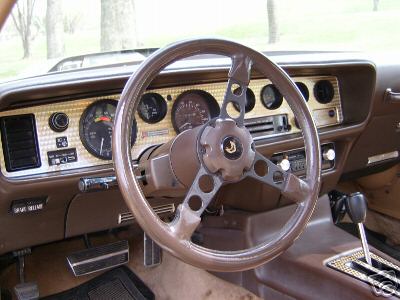Did Bandit Trans Ams all have T-tops?
No, they didn't. Most years, Bandit Trans Ams without t-tops were available on the option sheet and cost about $500 less.There are three special cases we have to discuss.
- In 1976, most of the black and gold limited editions did not have t-tops, but that was unplanned. The problems occured after the cars got to Hurst, so there's no indication of it on the build sheets.
- In 1978, no evidence has ever cropped up of any special edition built without t-tops. A lot of things didn't go according to plan in 1978, so it's possible such a car exists but has never been discovered. Pontiac Historical Services could also go through their records and look for such a car, but so far they haven't.
- 1979 Pontiac records show that all Special Editions had t-tops. These records are widely known to be wrong. Mike Farrell was nice enough to give me a copy of his build sheet, documenting a 1979 400 4-speed Y84 with no t-tops. Wow! The bad news is, we'll never know how rare it is, because Pontiac forgot they made it. Well, maybe PHS will count them someday, and then we'll know.
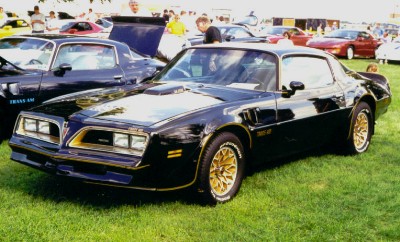
The first non-t-top Special Edition I ever saw was at the 1997 Trans Am nationals. It's a sleek look.

Did Bandit Trans Ams have Special T-tops?
Wellll, it depends. About half of them did. The first Special Editions, made from 1976 to early 1978, had Hurst Hatch t-tops, and they made a special black t-top for Special Editions. Regular Trans Ams got a silver-frame Hurst Hatch instead (like the one at right). Keep an open mind about errors at Hurst. I've never seen one, but cars could have been built with the "wrong" t-tops.Also, the Gold Editions had a special t-top. This is heavily discussed on the Bandit Trans Am Myth Page. After the Gold Editions, all the rest of the Special Editions had normal Fisher t-tops with a gold pinstripe stuck on them.
One for the weird file: According to published option lists, rain gutters were included in the Special Edition option package starting in 1980. I presume this means on the t-tops, because in 1980 they had t-tops with rain gutters on them. The question is, why? Of all the options to add to the package, how on earth did they pick only this one? It doesn't match the black or gold. It's not even good looking.
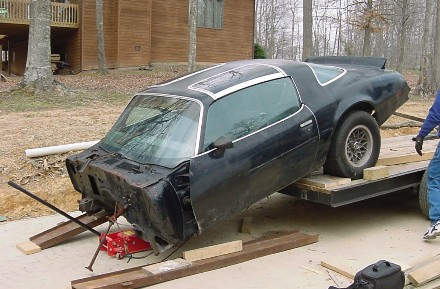
This ain't no Bandit Trans Am
Did Bandit Trans Ams have special wheels?
No, but sometimes they did have special colors and trim. This question is so hard, we almost need a chart to answer it. So let's make one:| Wheel type | Year Used | Was it Unique to Special Editions | Photo |
| Gold Honeycomb | 1976 | Color: Unique Trim: Regular | 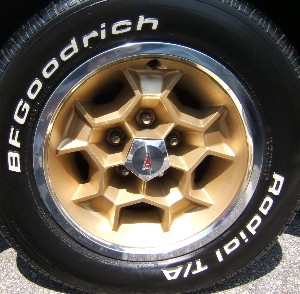 This is an unrestored ultra-low-mileage wheel. |
| Gold Snowflake Several versions:
| 1977-81 | Color: Regular Trim: Regular in 1977, Special in 1978-81. Gold Snowflakes were available on almost anything. Of course, the WS6 versions were only available on Trans Am and Formula. Starting in 1978, both black and gold Special Editions received unique gold chicken emblems in the center cap. I'm not sure exactly when this change occured. (see the red emblems question for more info.) The wheels at right are on unrestored cars with 10,000 miles or so. Both have faded (darkened) from their original color a little bit. Notice the bottom one is not on a Special Edition. There is a widely distributed myth that these wheels with unmachined spokes were only used on Y88 Gold Editions. | 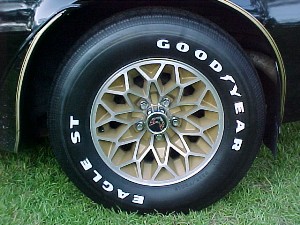 These are both very low-mileage, unrestored wheels. 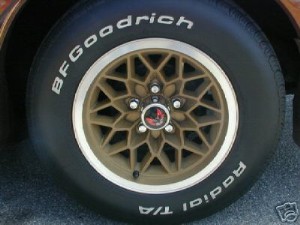 |
| Gold Rally II These are extremely rare, but they did happen. | 1977 only? | Color: Unique Trim: Regular Build sheet shows the center cap was "normal". This photo at right is courtesy of Matt Cucchiara, whose uncle bought one of these cars new, and as far as I know, has the only original low-mileage set on earth. | 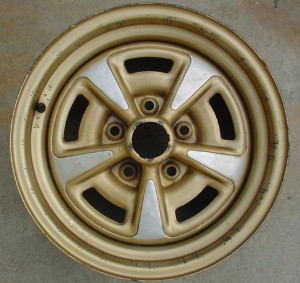 This wheel is also very low mileage, unrestored. |
| Gold Turbo Wheel Came in two sizes, but both were WS6 | 1980-81 | Color: Regular Trim: Unique Gold Turbo wheels on non-Special Editions are very unusual, and I had reported they were not available generally, but the instant replay clearly shows there was a slot on the order sheet to order gold ones with a variety of color schemes. This wheel is obviously unrestored, although I don't know its history. Weird File: Initially, you couldn't pick this wheel on the option list unless you ordered a Turbo engine with WS6. An announcement on November 20th, 1979, expanded availablility to 305-powered WS6 cars with California emissions. | 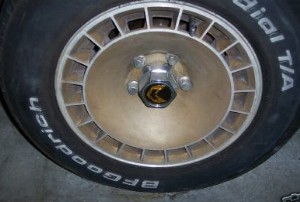 Gold Turbo wheels could be ordered on Turbocharged cars of several colors, including brown, maroon, black, bronze, and yellow. |
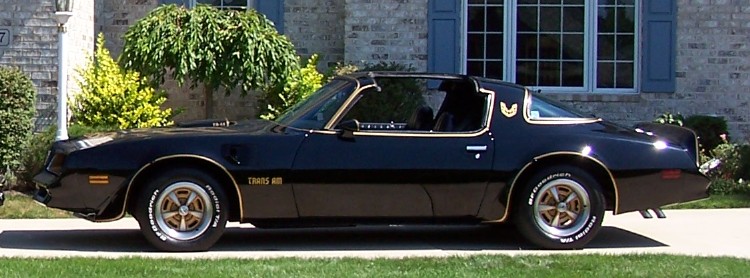
| I know you may be shocked by this gold Rally II stuff. It's not that important, and I don't want to dwell on it, but I do owe you at least one build sheet lest you think I'm kidding. Below is a section of a build sheet from an outrageously rare car - it's a Special Edition without T-tops and without Snowflakes. This car belongs to Fred Schramm, webmaster of Pontiacpower.net. I have a 1977 Saleman's handbook that shows the Special Edition package with 4 prices, depending on whether you took T-tops and/or snowflakes. I've heard anecdotes about a snowflake shortage causing these cars to be built, and customers who ordered cars having them come in like this without their permission. This photo at right is one of Fred's restored wheels with the trim on. | 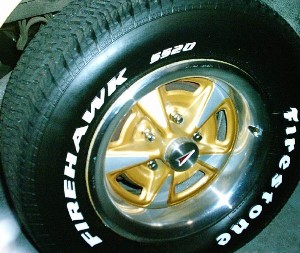 |

The build sheet shows N67, the body-colored Rally II option, but these wheels weren't body colored. The car was black, and the Rally II's were gold. Also notice this car has both Y82 and Y81 codes. Fred has collected a number of Y81 build sheets, and they're all that way. You should check out Fred's progress and encourage him at his site, pontiacpower.net
What Color are my wheels supposed to be?
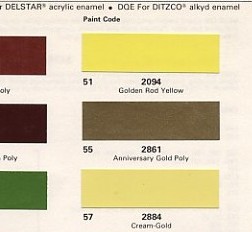 If you look at a set of 1976 Pontiac paint chips (far right), you'll see a #55 Anniversary Gold. That's our boy for 1976. Whole cars (50th anniversary Grand Prixs) were painted that color in 1976.
If you look at a set of 1976 Pontiac paint chips (far right), you'll see a #55 Anniversary Gold. That's our boy for 1976. Whole cars (50th anniversary Grand Prixs) were painted that color in 1976.
 In 1977, no paint chip exists that makes sense, but the gold "accent" color was given in a table (left) in the PPG paint chip sheets. The blue accent color here is for Skybirds. There has been a lot of debate about whether the wheels and grilles were the same color. I looked for a hard reference to this for years, and I have to thank Heeter Thomas for actually pointing out where it was. It's page 2C6 out of the ordinary shop manual (below.) Look at the last line in the picture below. This anwers all the questions for 1977.
In 1977, no paint chip exists that makes sense, but the gold "accent" color was given in a table (left) in the PPG paint chip sheets. The blue accent color here is for Skybirds. There has been a lot of debate about whether the wheels and grilles were the same color. I looked for a hard reference to this for years, and I have to thank Heeter Thomas for actually pointing out where it was. It's page 2C6 out of the ordinary shop manual (below.) Look at the last line in the picture below. This anwers all the questions for 1977.

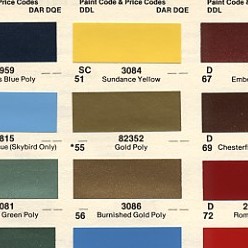 While there's no paint code given above, these formulations were identical in the 1978 shop manual, and there it does say code 55. The 1978 paint chips, closeup at right, shows 55 with a matching formulation number and a footnote that says "Also 1977 color, used as Firebird accent color.." You can find 1978 Code 55 in any set of paint chips at your auto paint store, or you can see the whole sheet here.
While there's no paint code given above, these formulations were identical in the 1978 shop manual, and there it does say code 55. The 1978 paint chips, closeup at right, shows 55 with a matching formulation number and a footnote that says "Also 1977 color, used as Firebird accent color.." You can find 1978 Code 55 in any set of paint chips at your auto paint store, or you can see the whole sheet here.
So our mystery is solved, at least through 1978. It's nice to know that the grille and wheels are supposed to be the same color, because they fade in opposite directions. The wheels turn dark (maybe it's the clearcoat?), but the grilles turn lighter as the paint fades, showing through the chrome underneath.
The 1976 and 1978 code 55's aren't actually the same formulation, but they look the same. One thing to be sure to avoid is 1977 Cream Gold #50. It's way too light, even lighter than the much more famous 1978 Solar Gold #50.
A good followup question might be what color are the wheels in 1979, 80, and 81? The build sheets continued to use 55, but paint chips don't show 55 after 1978.
Are Gold Editions all one color, wheels and all?
Heck no. The wheels are a lot darker than the car.Check out this ebay find. This car, and its wheels, are the same color. This is a good illustration of what, in my opinion, Code 55 looks like before it darkens, and what Gold Editions might have looked like if they were monochromatic.
Compare this color to the paint chips on this page. It may be a little bright, or it may just be the lighting. This is about the same color as OEM paints snowflake wheel gold. It's really bright compared to the old wheels, but I think it's about right. In GM factory photos, snowflakes appear very bright, with the machined surfaces as shiny as chrome.
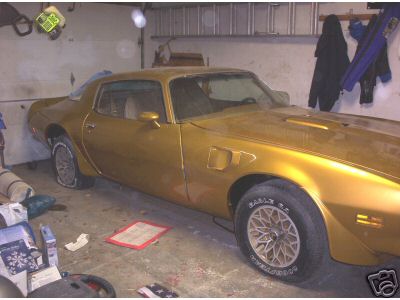
This ain't paint code 50
Are Bandit Trans Ams rare?
Boy, that's a tough one. Although Pontiac built over 50,000 black and gold Trans Am Special Editions over 6 model years, they're in short supply today. A typical issue of Hemmings Motor News features none, nada, zero for sale. Prices are skyrocketing. You can actually feed your family by making clones. For comparison, Pontiac built 7,500 TATA's, and about 7,497 of those are still pristine garage furniture. They have been treated like collector's items since day one. Since they're all alike, if you wanted one you could have one picked out by this weekend. In contrast, finding a real Special Edition that you like could take years.So why weren't Special Editions treated like instant collectibles? I think Smokey and the Bandit appealed to us in a way that we couldn't respect the Special Editions as garage furniture. They were the ultimate low class bad-guy show-off car in the 70's, and people drove them around all weekend smoking, driving drunk (was practically legal then) and picking up women (STDs were considered curable then), basically emulating Burt Reynolds. A lot of people let them sit out in the rain. The Hurst-equipped cars can't handle rain, and they rusted away to nothing. A few more fell into the hands of the Hot Rod Magazine crowd and were made into purple pretend drag racers. And, some people have taken the engines out of them under the mistaken impression that they're "fast". As in, "Billy Bob put a Bandit Trams Am engine in his Malibu." Never mind it's got 180 hp and 7:1 compression.
So that's a long way of saying that 25 years ago, most of them were used as tools to either pick up women or make other guys envious. Today, we still see a few totally trashed ones on the road. I have no real way to estimate, but based on what I've seen, I believe the majority have been trashed. I wouldn't go so far as to say the majority are already crushed.
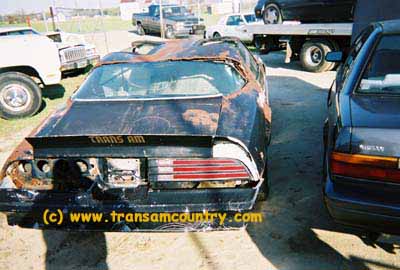
Yes, it's the real item - 4-speed Y82 with white interior. This car was discovered in this condition by Mike Barefoot, webmaster and founder of transamcountry.com
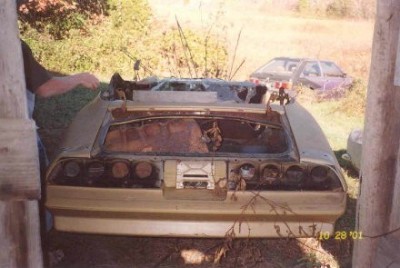
If that's not bad enough, here's a real gold edition with the roof cut off.
What's the most rare Bandit Trans Am?
That's easy, sort of. We have plenty of numbers, but we already know there were some cars built that Pontiac production records missed. For instance, nobody knows:- If any 1978 SE (either color) was made without t-tops;
- How many 1979 SE's were made without t-tops;
- How many 1980 SE's had delete-option engines;
- How many 1981 SE's had 305 automatics. (Was this for Canada only?)
If you just use the numbers on hand, you'd see that in 1980, only 12 Special Editions were built with Chevy 305 engine and no t-tops. There were 15 more built in 1981, but those were (if the records are right) 4-speeds and therefore more collectible. The Chevy engine is not a big selling point for collectors, but I guess it does have some advantages for a show-and-go car.
The next thing down the list, if you want something that looks like Burt Reynolds drove, is the 1978 Y-84. Only 20 4-speeds and 68 Pontiac 400-automatics were built. The problem is, since Y-84's and Y-82's are basically the same thing, you could just as easily lump these in with the 1978 Y-82's. Also, the 78 records are confusing, and may exclude the numerous L78 400-automatic cars. So, if you ignore the 1978 Y84, the next good picks would be any other non-t-top 1980-1981 (several to pick from), or a 1976 455 with T-tops, 110 built.
Delete-option rarity is not always collectible, but in the case of non-t-top Special Editions, it's a big plus. For one thing, the body is more rigid and performs better. For another, the cars look great. Third, they don't leak, so everything inside stays in better condition and they don't rust so much. Fourth, the old t-tops are really problematic 25 years later, and hard top owners get to miss all that. If you include all the non-t-top Special Editions built from 1979 to 1981, the cars would add up to a few hundred, not a few thousand. But rarity is just icing on top of how truly great they look. Just look at the first photo on this page. We've never owned one, but we're jealous.
Aren't all the red emblems replaced with gold on all bandits?
Not exactly. The 1976 had tiny red arrowheads in the wheels, but everything else was gold. They had a special gold nose emblem. The 1977 cars, like Burts Reynolds drove, had red nose arrowheads and red wheel emblems. There are some folks who claim they have a 1977 with gold wheel emblems. However, parts books, build sheets, and polls of the Bandit Trans Am club do not support this. I believe the build sheets most, although they they only give you a snap shot on that day. On my build sheets, all 1977 snowflake center caps were coded the same, with RF in block 75. In 1978, you start to see a mixture of RF and RS, with RS being on all the Gold Editions. So I think we can decode RF and RS to red and gold, respectively. (Nose emblem color isn't on the build sheet.)Eventually, we know there was a change, and I can get it within a few months. Dutch was built on June 6th, 1977 with red wheel and nose emblems. I have a Y82 build sheet dated January 26th, 1978, and this car has gold wheel emblems (code RS). Was that a 1978 model year change? mid-1978? ultra-late 1977? Did the nose arrowhead change at the same time? I don't know. The parts books seem to suggest it was a model year change.
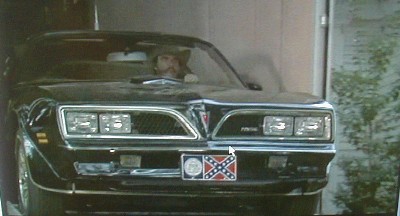
"Honey, Hush. Look at that"
Did all the Bandit Trans Ams have gold steering wheel spokes?
As a matter of fact, no. According to the "Firebird Decoding Guide", the gold spokes were discontinued on November 20th, 1979. The reason: The wheels used after that are steel. Here's a photo at right of an obvious 1981 Turbo Trans Am Special Edition. It's all correct, including two-tone peanut butter and chocolate interior, black/brown steering wheel, gold shifter plate, and gold dash plate.